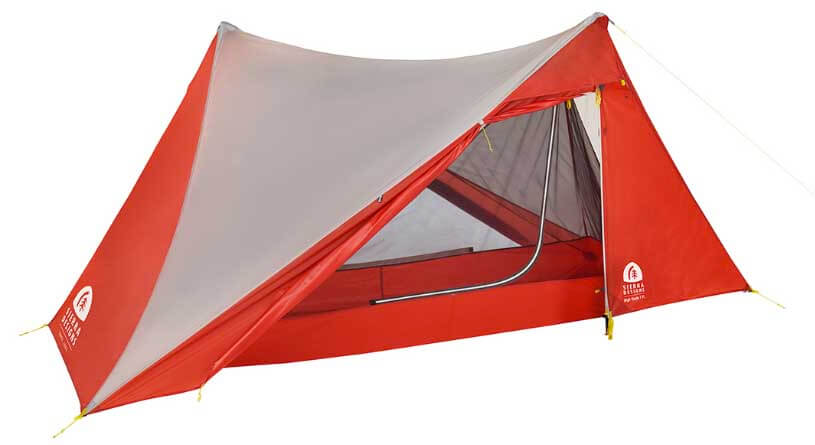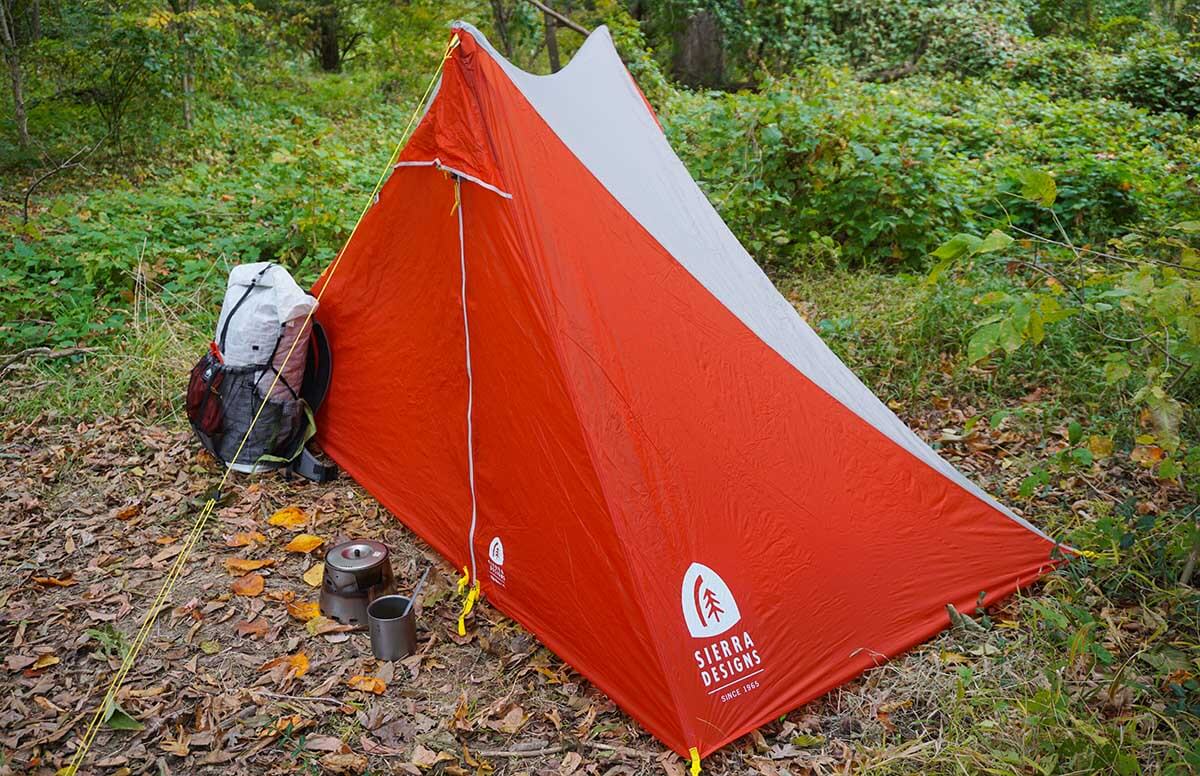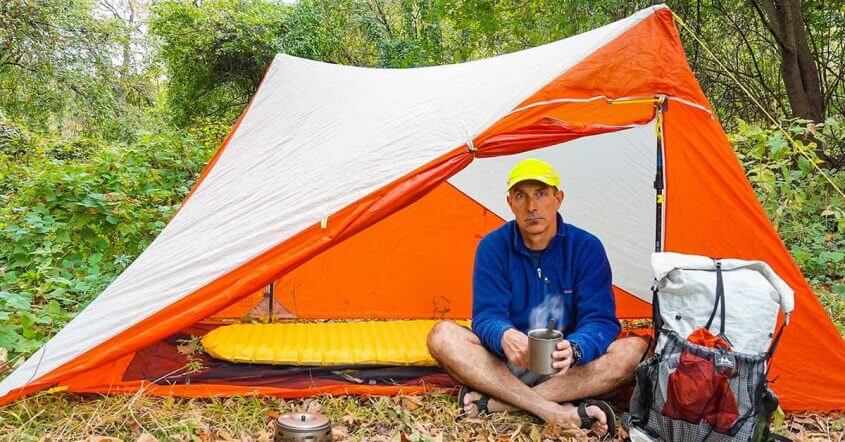Sierra Designs High Route 1 FL Tent Review
Used without the inner-nest, the Sierra Designs High Route 1 FL Tent deserves a serious look as an innovative, 2-PERSON pyramid shelter. But if you frequently use the outer shelter and inner-nest together, you might consider other options. E.g. lighter 1-person shelters like the TarpTent Notch, or Mountain Laurel Designs Solomid XL; or roomier, freestanding 2-person “true-tents” like the REI Quarter Dome 2 or Big Agnes Copper Spur HV UL 2 Tent. Even so, the outer shell alone is a very nice pyramid shelter and Sierra Designs and Andrew Skurka deserve a lot of credit for thinking outside the box.
Quick Spec’s
- The High Route 1 FL is a one-person, two-part shelter. An outer shell (pyramid shelter) and an inner-nest (bug net and floor). When combined they are the equivalent of a double walled tent.
- Shelter has no poles. It uses two trekking poles for structure.
- 2 lb 10 oz for: Outer shell, inner-nest, 8 stakes, 2 stuff sacks and cordage.
2 lb 5 oz min. trail weight (less stakes & stuff sacks)
What is the Sierra Designs High Route 1 FL Tent?
The Sierra Designs High Route 1 FL Tent is really “a pyramid shelter with an inner-nest option.” More specifically, it’s a 2-apex pyramid, meaning that two poles support the shelter at two “pyramid peaks.” A 2-apex pyramid (vs. single apex) provides more vertical walls and therefore more usable living area (in this case enough room for two people). If you want, you can attach the inner-nest, which gives you a floor and mosquito protection. The downside is that this reduces living area (down to 1-person), and significantly increases the time and complexity of setup.

Product shot that shows the integration of outer shell and inner-nest. The back of the “tent” is a mirror image of the front.
What’s Good
- Used separately, I like the outer shell and even the inner-nest. A lot of thought went into their design.
- In particular, the outer shell is an innovative pyramid shelter with lots of room. It could easily sleep 2 in a pinch. The vertical walls greatly increase usable room.
- The High Route has one of the best implementations of using trekking poles to support a pyramid shelter. I really like that the poles are snug against the outside walls. This keeps them entirely out of the living area and door area. In addition it adds to the structural integrity of the vertical walls.
- The dual doors and, two peak vents provide good ventilation.
- Properly guyed out*, the High Route does well in strong winds. (*due to the vertical walls it’s a good idea to anchor the peak guylines with strong Y-stakes solidly in the ground)
- It’s fairly easy to pitch due to its rectangular shape and using standard height trekking poles. (True only for the outer shell when used alone, i.e. no inner-nest.)

The inner-nest (floor and bug netting) for the High Route can work as a stand-alone, stargazing shelter. The picture also better shows the dual apex design of the shelter. Note how the trekking poles are completely clear of the doors and living area.
What’s Not So Good
The High Route is less attractive when you combine the inner-nest with the outer shell
- The combination is heavy for a 1-person non-freestanding tent that uses trekking poles for support.
- In fact, the 1-person High Route is comparable in weight to some 2-person freestanding dome shelters that have a lot more interior room than the High Route and are easier setup. E.g the Big Agnes Copper Spur HV UL 2 Tent or even the comparably priced REI Quarter Dome 2 Tent. (Both have a newer steeper walled design that improves living area.)
- And there are lighter 1 person pyramid with inner-nest shelters like the 27 oz TarpTent Notch, or Mountain Laurel Designs Solomid XL with InnerNest.
- The High Route inner-nest halves your living area and increases overall weight. It also leaves scant “vestibule” area between the inner and outer tents.
- I found attaching the inner-nest a bit awkward, fiddly, and time consuming. There’s lots of clipping and then tension adjustments at every point, since no shock-cordage is used. All this is done crouched on your knees, many times reaching across the tent.

Oblique view of the High Route showing the near vertical front wall, and the two apexes of the shelter. The rear wall (not visable) is a mirror image of the front wall you can see. Due to the vertical it’s a good idea to stake out the front guyline to the apex (lower left guline in photo) with a solid Y-stake if you expect strong winds.
Summary
When used without the inner-nest, theSierra Designs High Route 1 FL Tent is worth a serious look. It is an innovative pyramid shelter that would likely work for two people. It even has dual doors! It’s made roomier by vertical walls and getting the trekking poles out of the living area. At about 12 oz per person (body less stakes is ~24 oz), it’s a reasonably light option for two people.
It’s a shame that Sierra Designs doesn’t sell just the outer shell (pyramid shelter portion) separately like other manufactures, e.g. Hyperlite Mountain Gear, Mountain Laurel Designs and TarpTent. But if you can get the High Route on sale at around $240, you could just buy the whole thing and leave the inner-nest at home.
But, if you think you’ll use the High Route outer shelter and inner-nest together most of the time, you might consider another shelter. Either lighter pyramid shelter with inner-nest combos from Hyperlite Mountain Gear, or the 27 oz TarpTent Notch and Mountain Laurel Designs Solomid XL with InnerNest. Or just getting a 2-person, freestanding, double-walled dome tent like the Big Agnes Copper Spur HV UL 2 Tent or the REI Quarter Dome 2 Tent, which is the same price, sleeps two and is only ½ pound heavier.
Detailed Technical Specifications
My measurements
- 2 lb 10 oz for: Outer shell, inner-nest, 8 stakes, 2 stuff sacks and cordage
- 24 oz Outer Shell (pyramid), 15 oz Inner-Nest
_____________________________________
* Technical Specifications (Sierra Designs)
- Minimum Weight: 2 lbs 5 oz / 1.05 kg
- Packaged Weight: 2 lbs 12 oz / 1.25 kg
- Number of Doors: 2
- Number of Gear Closets: Internal Storage
- Gear Storage Area (Tarp Area – Nest Area): 17.3 ft2 / 1.61 m2 (more of a narrow area around the perimeter than a vestibule)
- Interior Area (Tarp): 36 ft2 / 3.34 m2
- Interior Area (Nest): 18.8 ft2 / 1.75 m2
- Internal Peak Height (Tarp): 48 in / 122 cm
- Internal Peak Height (Nest): 43 in / 109 cm
- Awning Height: 38.5 in / 98 cm
- Length (Tarp): 108 in / 274 cm
- Width (Tarp): 48 in / 122 cm
- Length (Nest): 90 in / 229 cm
- Width (Nest): 30 in / 76 cm
* from the Sierra Designs Site, on the “TECH SPECS” tab



